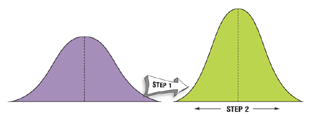|
ROLES & BENEFITS
What can Design Of Experiments do for you?
The graphic on the right shows how with DOE you can optimize your process
or product in step 1 by first minimizing variation by maximizing the signal-to-noise
ratios of the controllable factors that affect variation.
Then, in step 2, select the levels of the tuning factor(s) that affect the mean to
adjust the mean in the desired direction (toward the target value).
Benefits
Design of Experiments (DOE) has provided documented substantial savings to thousands of
companies by solving difficult quality problems, reducing product and process variation,
and optimizing product/process performance and consistency.
The
Power of DOE
DOE is a very powerful analytical method that can be taught to technical professionals at
a very practical level, providing a cost-effective and organized approach to conducting
industrial experiments:
Multiple product design and/or process variables can be studied at the same time with
these efficient designs, instead of in a hit-and-miss approach, providing very
reproducible results.
Due to the statistical balance of the designs, thousands of potential combinations of
numerous variables (at different settings or levels) can be evaluated for the best overall
combination, in a very small number of experiments.
This not only saves experimental costs, but it greatly increases the odds of identifying
the hard-to-find solution to nagging quality problems. |
|

|

